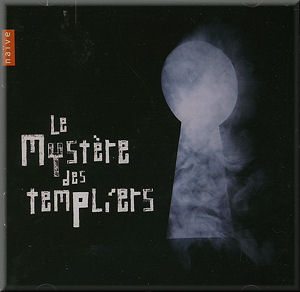 |
 |
|


alternatively
CD:
AmazonUK
AmazonUS
|
Le Mystère des Templiers
Anonymous 12th Century
Crucem sanctam, antiphon for choir [8:18] (1)
Honor virtus et potestas, responsorium for choir [5:46] (1)
Kyrie eleïson, for choir [7:22] (1)
Anonymous, Notre Dame School
Benedicamus Domino, organum for 3 voices [5:19] (4)
Anonymous, Hymnaire de Pairis
Enixa est puerpera, hymn [3:03] (2)
Fa fa mi fa mi re [1:04] (2)
Anonymous
Canticum exercuit, clausule-motet [2:18] (3)
Redit etas aurea [2:15] (3)
Christus patris gratie [3:33] (3)
Uterus hodie virginis floruit, versus [2:46] (2)
Leonin (1150-1210) and Pérotin
(1160-1230), attrib.
Et Valde, organum for 2 voices, responsory [7:38] (4)
Hildegard von Bingen (1098-1179)
Cum vox sanguinis, hymn for Saint Ursula and her companions
[6:31] (2)
O rubor sanguinis, antiphon for Saint Ursula and her companions
[1:31] (2)
Gauthier de Coincy (1178-1236)
Ma viele [4:08] (3)
Alfonso X (el Sabio) (1221-1284)
Cantiga de Santa María 29, Nas mentes senpre teer
[1:50] (4)
Cantiga de Santa María 350, Santa María, Sennor
[3:07] (4)
 Ensemble Organum/Marcel Pérès (1); Discantus/Brigitte
Lesne (2); Alla Francesca (3); Ensemble Gilles Binchois/Dominique
Vellard (4)
Ensemble Organum/Marcel Pérès (1); Discantus/Brigitte
Lesne (2); Alla Francesca (3); Ensemble Gilles Binchois/Dominique
Vellard (4)
rec. 2009, France. DDD
 NAÏVE AMBROISIE AM195 [66:29]
NAÏVE AMBROISIE AM195 [66:29] 
|
|
|
This CD from the ever-enterprising Naïve label is a compilation
of 16 tracks from other recordings by four specialist groups:
Ensemble Organum (directed by Marcel Pérès), Discantus
(by Brigitte Lesne), Ensemble Gilles Binchois (Dominique Vellard)
and Alla Francesca. They have three, five, four and four numbers
respectively. The inspiration, the theme if you prefer, is the
two hundred or so history of the Knights Templar.
After the First Crusade (1095-1099 CE) Hugues de Payns (d. 1136)
formed a religious community, originally of nine knights, which
would serve the Christian God not as monks or clerics - but
as soldiers; milites Christi. Their first home was in
a wing of his palace on the Temple Mount (now the Al-Aqsa mosque);
hence their name - here the Templiers. Indirectly the
movement in its wider form gave rise not only to seven more
crusades (until 1270), but also, paradoxically, to the revival
of the Christian pilgrimage thanks to greater and deeper personal
spirituality.
These changes in turn sponsored (and were inevitably fed by)
a flowering of the arts, including secular music. These were
by and for lay people, not merely the privileged churches and
their communities. And here on this CD is a representative selection…
music by Hildegard of Bingen (1098-1179), Gauthier de Coincy
(1178-1236) and Alfonso X, el Sabio, (1221-1284). The majority
of works here, though, are by anonymous writers from the eleventh
to the early thirteenth centuries. One of the longest pieces
[tr.2] (none lasts much over eight minutes) is attributed to
Leonin (1150-1210) and Pérotin (1160-1230) - at least
to clerics at Notre Dame. Then Enixa est puerpera [tr.15]
is somewhat redolent of Hildegard too. At the other end of the
continuum is the inclusion of instruments in secular music.
Amongst other developments reflected in the selection of music
here is that from monastic monody to urban polyphony in the
cathedrals.
The task of surveying the music of two hundred years, even with
a specific theme of the changes parallel to the rise and fall
of the Templars, is not a simple one. Nor one that's easily
contained in just over an hour's music. If you didn't know the
historical background, then this might seem like just another
selection of mediaeval music. In that sense, the 'concept' has
- and should - take second place to the substance of the performances.
And these are performances which should, and can, be appreciated
and enjoyed in their own right. Since the standard of performance
- technically and in terms of commitment to inspiration - is
as high as one would expect of these four groups, that can still
happen. But just how relevant the rooting of origins and sources
in the Templars is when the music at the same time has multiple
other strengths and attributes is open to question. It does
remain impressive music, nevertheless.
The acoustics in which these recordings were made are all appropriate
to the works performed. The CD has a useful essay aiming to
tie the themes and music together; though no texts. And there
are errors - even about what's on the CD. Given the limitations
just alluded to, you may want, rather, to seek out the complete
recordings and pursue each in its own right. But as a sampler,
this collection will provide a useful introduction.
Mark Sealey
|
|

